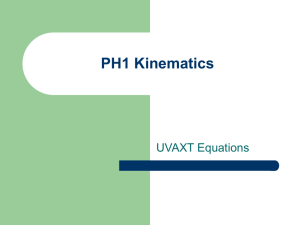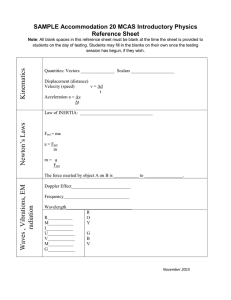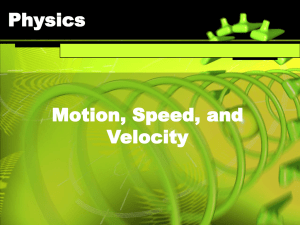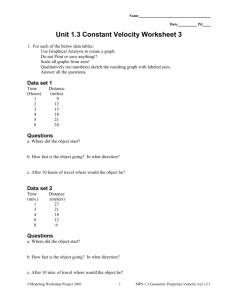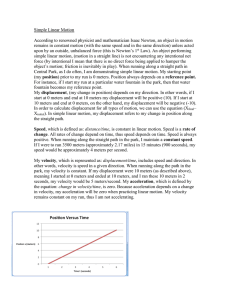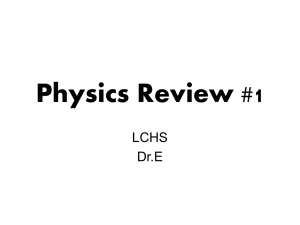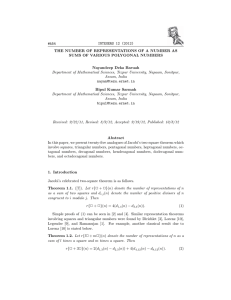Mr. Emrick Northwestern High School Physics Name Pd _____ 1st
advertisement
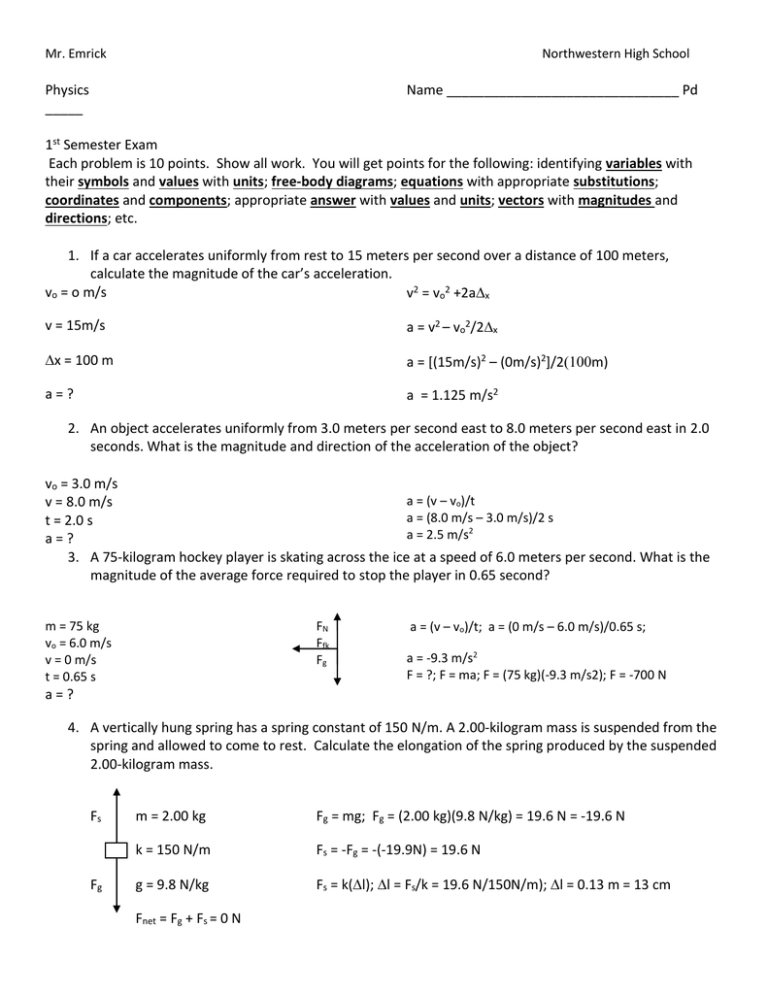
Mr. Emrick Northwestern High School Physics _____ Name _______________________________ Pd 1st Semester Exam Each problem is 10 points. Show all work. You will get points for the following: identifying variables with their symbols and values with units; free-body diagrams; equations with appropriate substitutions; coordinates and components; appropriate answer with values and units; vectors with magnitudes and directions; etc. 1. If a car accelerates uniformly from rest to 15 meters per second over a distance of 100 meters, calculate the magnitude of the car’s acceleration. vo = o m/s v2 = vo2 +2ax v = 15m/s a = v2 – vo2/2x x = 100 m a = [(15m/s)2 – (0m/s)2]/2m) a=? a = 1.125 m/s2 2. An object accelerates uniformly from 3.0 meters per second east to 8.0 meters per second east in 2.0 seconds. What is the magnitude and direction of the acceleration of the object? vo = 3.0 m/s a = (v – vo)/t v = 8.0 m/s a = (8.0 m/s – 3.0 m/s)/2 s t = 2.0 s a = 2.5 m/s2 a=? 3. A 75-kilogram hockey player is skating across the ice at a speed of 6.0 meters per second. What is the magnitude of the average force required to stop the player in 0.65 second? m = 75 kg vo = 6.0 m/s v = 0 m/s t = 0.65 s FN Ffk Fg a = (v – vo)/t; a = (0 m/s – 6.0 m/s)/0.65 s; a = -9.3 m/s2 F = ?; F = ma; F = (75 kg)(-9.3 m/s2); F = -700 N a=? 4. A vertically hung spring has a spring constant of 150 N/m. A 2.00-kilogram mass is suspended from the spring and allowed to come to rest. Calculate the elongation of the spring produced by the suspended 2.00-kilogram mass. Fs Fg m = 2.00 kg Fg = mg; Fg = (2.00 kg)(9.8 N/kg) = 19.6 N = -19.6 N k = 150 N/m Fs = -Fg = -(-19.9N) = 19.6 N g = 9.8 N/kg Fs = k(l); l = Fs/k = 19.6 N/150N/m); l = 0.13 m = 13 cm Fnet = Fg + Fs = 0 N 5. A car traveling on a straight road at 15.0 m/s accelerates uniformly to a speed of 21.0 m/s in 12.0 seconds. Determine the magnitude of the displacement of the car during this 12.0-second time interval. velocity vs. time graph vo = 15.0 m/s v = 21.0 m/s t = 12.0 s a=? x = ? a = (v – vo)/t = (21.0m/s – 15.0 m/s)/12.0s a = 0.500 m/s2 x = (vo)(t) + ½ (a)(t2) x = (15.0 m/s)(12 s) + ½ (0.500 m/s2)[(12 s)2] x = 216 m Area between the solid line and the zero line of the grid is equal to the displacement. area of triangle = ½ (base)(height) area = ½ (12s)(21m/s – 15m/s) = 36 m area of rectangle = (base)(height) area = (12s)(15 m/s) = 180 m total area = displacement = 216 m 6. A 0.149-kilogram baseball, initially moving at 15 m/s, is brought to rest in 0.040 second by a baseball glove on a catcher’s hand. Calculate the magnitude and direction of the average force exerted on the ball by the glove. m = 0.149 kg vo = 15 m/s v = 0 m/s t = 0.040 s a=? F=? a = (v – vo)/t a = (0m/s – 15 m/s)/0.040 s = -375 m/s2 Fnet = ma Fnet = (0.149 kg)(-375 m/s2) = 55.8 N 7. A student standing on the roof of a 50.0-meter-high building kicks a stone at a horizontal speed of 4.00 meters per second. How far from the base of the building does the stone hit the ground? 2-dimensional (vertical, y, and horizontal, x) y = 50.0 m ay = 9.80m/s2 x = (vox)t+ ½ (ax)(t2) ax = 0m/s2 y = (voy)t + ½ (ay)(t2) voy = 0 m/s 50.0 m = (0m/s)(t) + ½ (9.80 m/s2)(t2) vox = 4.00m/s t = 3.19s t=? x = (4.00m/s)(3.19s)2 = 40.8 m x = ? 8. A 24-newton force is acting at 35° above the horizontal. What are the magnitudes of the horizontal and vertical components of this force? F = 24N 35o Fy Fx Fx = Fhorizontal = (F)(cos) = 24N(cos 35o) = 19.7N Fy = F(sin) = 24N(sin35o) = 13.8N Use the following graph to answer questions 9 and 10. Velocity vs Time 25 Velocity (m/s) 20 15 Velocity vs Time 10 5 0 0 2 4 6 Time (s) 9. What is the acceleration of the car at t = 4.0 seconds? slope of a velocity vs. time graph = acceleration slope of line from 0 s to 5 s = (v2 – v1)/(t2 – t1) = (20 m/s – 0 m/s)/ (5.0 s – 0.0 s) = 4.0 m/s2 10. What is the total distance traveled by the car during this 6.0-second interval? To determine displacement, calculate the area beneath the velocity vs. time graph. area of triangle = ½ (base)(height) = ½ (5.0 s)(20.0 m/s) = 100 m area of rectangle = (length)(height) = (1.0 s)(20.0 m/s) = 20 m displacement = total area = 120 m

